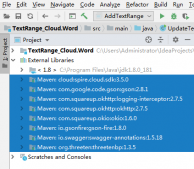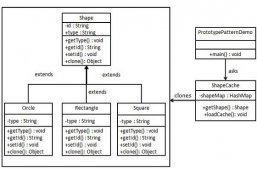jedis是redis的java客户端,spring将redis连接池作为一个bean配置。
redis连接池分为两种,一种是“redis.clients.jedis.shardedjedispool”,这是基于hash算法的一种分布式集群redis客户端连接池。
另一种是“redis.clients.jedis.jedispool”,这是单机环境适用的redis连接池。
maven导入相关包:
|
1
2
3
4
5
6
|
<!-- redis依赖包 --><dependency> <groupid>redis.clients</groupid> <artifactid>jedis</artifactid> <version>2.9.0</version></dependency> |
shardedjedispool是redis集群客户端的对象池,可以通过他来操作shardedjedis,下面是shardedjedispool的xml配置,spring-jedis.xml:
|
1
2
3
4
5
6
7
8
9
10
11
12
13
14
15
16
17
18
19
20
21
22
23
24
25
26
27
28
29
30
31
32
33
|
<?xml version="1.0" encoding="utf-8"?><beans xmlns="http://www.springframework.org/schema/beans" xmlns:xsi="http://www.w3.org/2001/xmlschema-instance" xmlns:context="http://www.springframework.org/schema/context" xsi:schemalocation="http://www.springframework.org/schema/beans http://www.springframework.org/schema/beans/spring-beans.xsd http://www.springframework.org/schema/context http://www.springframework.org/schema/context/spring-context.xsd"> <!-- 引入jedis的properties配置文件 --> <!--如果你有多个数据源需要通过<context:property-placeholder管理,且不愿意放在一个配置文件里,那么一定要加上ignore-unresolvable=“true"--> <context:property-placeholder location="classpath:properties/redis.properties" ignore-unresolvable="true" /> <!--shardedjedispool的相关配置--> <bean id="jedispoolconfig" class="redis.clients.jedis.jedispoolconfig"> <!--新版是maxtotal,旧版是maxactive--> <property name="maxtotal"> <value>${redis.pool.maxactive}</value> </property> <property name="maxidle"> <value>${redis.pool.maxidle}</value> </property> <property name="testonborrow" value="true"/> <property name="testonreturn" value="true"/> </bean> <bean id="shardedjedispool" class="redis.clients.jedis.shardedjedispool" scope="singleton"> <constructor-arg index="0" ref="jedispoolconfig" /> <constructor-arg index="1"> <list> <bean class="redis.clients.jedis.jedisshardinfo"> <constructor-arg name="host" value="${redis.uri}" /> </bean> </list> </constructor-arg> </bean></beans> |
下面是单机环境下redis连接池的配置:
|
1
2
3
4
5
6
7
8
9
10
11
12
13
14
15
16
17
18
19
20
21
22
23
24
25
26
27
28
29
30
31
|
<?xml version="1.0" encoding="utf-8"?><beans xmlns="http://www.springframework.org/schema/beans" xmlns:xsi="http://www.w3.org/2001/xmlschema-instance" xmlns:context="http://www.springframework.org/schema/context" xsi:schemalocation="http://www.springframework.org/schema/beans http://www.springframework.org/schema/beans/spring-beans.xsd http://www.springframework.org/schema/context http://www.springframework.org/schema/context/spring-context.xsd"> <!-- 引入jedis的properties配置文件 --> <!--如果你有多个数据源需要通过<context:property-placeholder管理,且不愿意放在一个配置文件里,那么一定要加上ignore-unresolvable=“true"--> <context:property-placeholder location="classpath:properties/redis.properties" ignore-unresolvable="true" /> <!--jedis连接池的相关配置--> <bean id="jedispoolconfig" class="redis.clients.jedis.jedispoolconfig"> <!--新版是maxtotal,旧版是maxactive--> <property name="maxtotal"> <value>${redis.pool.maxactive}</value> </property> <property name="maxidle"> <value>${redis.pool.maxidle}</value> </property> <property name="testonborrow" value="true"/> <property name="testonreturn" value="true"/> </bean> <bean id="jedispool" class="redis.clients.jedis.jedispool"> <constructor-arg name="poolconfig" ref="jedispoolconfig" /> <constructor-arg name="host" value="${redis.host}" /> <constructor-arg name="port" value="${redis.port}" type="int" /> <constructor-arg name="timeout" value="${redis.timeout}" type="int" /> <constructor-arg name="password" value="${redis.password}" /> <constructor-arg name="database" value="${redis.database}" type="int" /> </bean></beans> |
对应的classpath:properties/redis.properties.xml为:
|
1
2
3
4
5
6
7
8
9
10
11
12
13
14
15
|
#最大分配的对象数redis.pool.maxactive=200#最大能够保持idel状态的对象数redis.pool.maxidle=50redis.pool.minidle=10redis.pool.maxwaitmillis=20000#当池内没有返回对象时,最大等待时间redis.pool.maxwait=300#格式:redis://:[密码]@[服务器地址]:[端口]/[db index]redis.uri = redis://:12345@127.0.0.1:6379/0redis.host = 127.0.0.1redis.port = 6379redis.timeout=30000redis.password = 12345redis.database = 0 |
二者操作代码类似,都是先注入连接池,然后通过连接池获得jedis实例,通过实例对象操作redis。
shardedjedis操作:
|
1
2
3
4
5
6
7
8
9
10
11
12
13
14
15
16
17
18
19
20
21
22
|
@autowiredprivate shardedjedispool shardedjedispool;//注入shardedjedispool@requestmapping(value = "/demo_set",method = requestmethod.get)@responsebodypublic string demo_set(){ //获取shardedjedis对象 shardedjedis shardjedis = shardedjedispool.getresource(); //存入键值对 shardjedis.set("key1","hello jedis"); //回收shardedjedis实例 shardjedis.close(); return "set";}@requestmapping(value = "/demo_get",method = requestmethod.get)@responsebodypublic string demo_get(){ shardedjedis shardedjedis = shardedjedispool.getresource(); //根据键值获得数据 string result = shardedjedis.get("key1"); shardedjedis.close(); return result;} |
jedis操作:
|
1
2
3
4
5
6
7
8
9
10
11
12
13
14
15
16
17
18
19
20
21
22
|
@autowiredprivate jedispool jedispool;//注入jedispool@requestmapping(value = "/demo_set",method = requestmethod.get)@responsebodypublic string demo_set(){ //获取shardedjedis对象 jedis jedis = jedispool.getresource(); //存入键值对 jedis.set("key2","hello jedis one"); //回收shardedjedis实例 jedis.close(); return "set";}@requestmapping(value = "/demo_get",method = requestmethod.get)@responsebodypublic string demo_get(){ jedis jedis = jedispool.getresource(); //根据键值获得数据 string result = jedis.get("key2"); jedis.close(); return result;} |
总结
以上就是这篇文章的全部内容了,希望本文的内容对大家的学习或者工作具有一定的参考学习价值,谢谢大家对服务器之家的支持。如果你想了解更多相关内容请查看下面相关链接
原文链接:https://blog.csdn.net/u014320421/article/details/80576232














